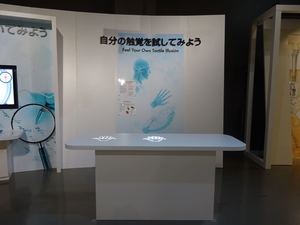Nagoya City Science Museum
TOP > Exhibition Guide > Keyword Search > Starting with "I" > illusion > Feel Your Own Tactile Illusion
Feel Your Own Tactile Illusion



Purpose of Exhibition
There are three shining hand forms on the table. Place your hand on one of them, and a realistic image of insects, a flame, or ice are projected, as if moving about and reaching up to your arm. At this moment, you will feel the sensation of a moving insect, warmth, or coldness on your hand, which does not actually exist.
Here, you will see how what you see influences what you feel to the touch with concrete examples.
If you are here with your friends, you can see how each person experiences an illusion differently.
Additional Knowledge
[How do we sense what we touch?]
The skin conveys information received about stimuli such as temperature, vibration, and pressure. It is believed that sensory receptors in the skin capture warmth, coldness, pain, and other stimuli, by type. These information are conveyed to the central nervous system (spinal cord and brain).
Sensory receptors in the skin
(Epidermis)
1. Meissner’s corpuscles (touching)
2. Free nerve endings (feeling warm, cold, or pain)
3. Merkel cells (touching)
(Dermis)
4. Ruffini corpuscles (being pulled)
(Subcutaneous tissue)
5. Lamellar corpuscles (being pressed)
6. Hair follicle receptors (feeling hair move)
[How do we smell or taste?]
Our olfactory (smelling) and gustatory (tasting) senses allow us to tell how something smells or tastes when it is mixed in the viscous liquid of the nasal mucosa or in the saliva.
A substance attaches itself to a receptor on the surface of an olfactory cell in the nose or gustatory cell in taste buds on the tongue. Different types of substances match with different receptors. Types of activated receptors and their combinations convey information about the substance to the brain.
[How does an illusion occur?]
Scientists are still working to find out why an illusion happens. There may be different reasons for different stimuli and different types of illusion.
Sometimes an illusion is explained as the result of the way the brain receives and understands (interprets) information. In other words, when the brain is not provided with a full set of information, it compensates for the missing information based on the past experiences.
Article by Tomoko Horiuchi, curator
